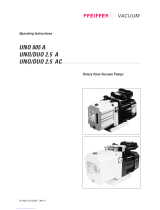Make sure that the seal ring (43) is inserted into the filling plug (c,
42) and undamaged, replace if necessary
Firmly reinsert the filling plug (c, 42) together with the seal ring
(43)
Checking the Colour of the Oil
Note: The oil should be light, either transparent, a little foamy or a little
tarnished. A milky discolouration that does not vanish after sedation of
the oil indicates contamination with foreign material. Oil that is either
contaminated with foreign material or burnt must be changed
(page 10: Oil Change).
In case the oil appears to be contaminated with water or other conden-
sates despite proper use of the gas ballast:
Replace the filter
Oil Life
The oil life depends very much on the operating conditions. A clean
and dry air stream and operating temperatures below 100 °C are ideal.
Under these conditions the oil shall be changed every 500 to 2000 op-
erating hours or after half a year.
Under very unfavourable operating conditions the oil life can be less
than 500 operating hours. Extremely short life times indicate malfunc-
tions ( page 13: Troubleshooting) or unsuitable operating conditions,
though.
Chosing a synthetic oil instead of a mineral oil can extend the oil life.
To select the oil best suited oil for your process please contact your
Busch representative.
If there is no experience available with regard to the oil life under the
prevailing operation conditions, it is recommended to have an oil anal-
ysis carried out every 500 operating hours and establish the change in-
terval accordingly.
Oil Change
DANGER_age32
In case the vacuum pump conveyed gas that was contaminated
with harmful foreign material the oil will be contaminated with
harmful material.
Danger to health during the changing of contaminated oil.
Danger to the environment.
Personal protective equipment must be worn during the changing
of contaminated oil.
Contaminated oil is special waste and must be disposed of sepa-
rately in compliance with applicable regulations.
Draining Used Oil
Note: After switching off the vacuum pump at normal operating tem-
perature wait no more than 20 minutes before the oil is drained (the oil
shall still be warm when being drained).
Make sure that the vacuum pump is shut down and locked against
inadvertent start up
Make sure that the vacuum pump is vented to atmospheric pres-
sure
Put a drain tray underneath the drain port (a, 31)
Remove the drain plug (a, 31) and drain the oil
When the oil stream dwindles:
Reinsert the drain plug (a, 31)
Switch the vacuum pump on for a few seconds
Make sure that the vacuum pump is shut down and locked against
inadvertent start up
Remove the drain plug (a, 31) again and drain the remaining oil
Make sure that the seal ring (30) is inserted into the drain plug (a,
31) and undamaged, replace if necessary
Firmly reinsert the drain plug (a, 31) together with the seal ring
(30)
Dispose of the used oil in compliance with applicable regulations
Flushing the Vacuum Pump
WARNING_ad
Degraded oil can choke pipes and coolers.
Risk of damage to the vacuum pump due to insufficient lubrica-
tion.
Risk of explosion due to overheating.
If there is a suspicion that deposits have gathered inside the
vacuum pump the vacuum pump shall be flushed.
Make sure that all the used oil is drained
Create 0.45 litres flushing agent from 50 percent oil and 50 per-
cent paraffin or diesel fuel/fuel oil
Make sure that the drain plug (a, 31) is firmly inserted
Remove the filling plug (c, 42)
Fill in the flushing agent
Firmly reinsert the filling plug (c, 42)
Close the suction line
Run the vacuum pump for at least half an hour
Drain the flushing agent and dispose of it in compliance with appli-
cable regulations
Note: Due to the use of paraffin and even more in case of using diesel
fuel/fuel oil, an unpleasant odour can occur after recommissioning. If
this is a problem, diesel fuel/fuel oil should be avoided and the vacuum
pump be run at idle in a suitable place until the unpleasant odour
vanishes.
Filling in Fresh Oil
Keep 0.45 litres oil acc. to the table Oil ( page 21) ready
Note: The amount given in these operating instructions is a guide. The
sight glass (b, 32) indicates the actual amount to be filled in.
Make sure that the drain plug (a, 31) is firmly inserted
CAUTION_a
Filling oil through the suction connection (g) will result in breakage
of the vanes (l, 8) and destruction of the vacuum pump.
Oil may be filled through the filling port (c, 42) only.
Remove the filling plug (c, 42)
Fill in approx. 0.45 litres of oil
Make sure that the level is between the MIN and the MAX-mark-
ings of the sight glass (b, 32)
Make sure that the seal ring (43) is inserted into the filling plug (c,
42) and undamaged, replace if necessary
Firmly reinsert the filling plug (c, 42) together with the seal ring
(43)
Exhaust Filter
Checks during Operation
Busch recommends the use of a filter pressure gauge (available as ac-
cessory, page 20: Accessories). Without filter pressure gauge the fil-
ter resistance shall be assessed on the basis of the drive motor current
drawn.
Maintenance KB/KC 0025 F
page 10























